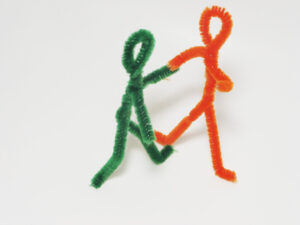With Valentine’s Day coming up, I’m going to talk to those of you who are seeking an intimate relationship but are not in one now. I am going to give you three keys to finding the right relationship for you.
The first is growing more whole in yourself. We have all heard that expecting another to complete ourselves is not a good way to form a relationship. Two whole people make the possibility of a good relationship real. So personal work to increase your self-esteem is important.
 One way to do this is to look at patterns you have repeated in relationships. Is there a certain type of partner that you have picked? People tend toward one end of a spectrum or the other on a number of characteristics: extroverted/introverted, independent/gregarious, witty/serious, emotionally changeable/steady, responsible/irresponsible, impulsive/deliberate, aggressive/passive, easygoing/structured, expressive/reserved, planner/spontaneous, and so forth. If you have picked partners whom you can describe with two or three words on these spectrums, then you are probably picking someone who has traits that you are uncomfortable expressing yourself. If you can discern what personality traits in partners attracted you, you might try to develop these underdeveloped parts of yourself. As you express (or contain) more of yourself, you may not have to pick another person to do it for you.
One way to do this is to look at patterns you have repeated in relationships. Is there a certain type of partner that you have picked? People tend toward one end of a spectrum or the other on a number of characteristics: extroverted/introverted, independent/gregarious, witty/serious, emotionally changeable/steady, responsible/irresponsible, impulsive/deliberate, aggressive/passive, easygoing/structured, expressive/reserved, planner/spontaneous, and so forth. If you have picked partners whom you can describe with two or three words on these spectrums, then you are probably picking someone who has traits that you are uncomfortable expressing yourself. If you can discern what personality traits in partners attracted you, you might try to develop these underdeveloped parts of yourself. As you express (or contain) more of yourself, you may not have to pick another person to do it for you.
Another way to look at this is to ask whether you pick people who fulfill your needs in ways that do not serve you. This happens, for instance, when a caretaker picks an addict or a pleaser picks someone who does not respect others’ boundaries. When this happens, to grow means to let go of an unhealthy need. It means to develop ways of being that are hard but better for you, like letting others deal with their own consequences or saying no. And don’t be afraid to pick someone next time who doesn’t fit your pattern.
More generally, building self-esteem is a process of finding where you are not comfortable about yourself and releasing unfounded ideas about yourself. Self-help books, therapy or coaching, experiential trainings, self-help groups, feeling the fear and doing it anyway—any and all these can help.
The second key is to be out there trying. You cannot be sitting at home hoping the right person will come along. Meeting new people and that frightening idea of dating are important. It is not just that you may find the person through purposely meeting or dating new people, although you might. Just as importantly, you will be ready when a good potential partner shows up, which can happen in the most unexpected ways and places. If you have been practicing by meeting new people, you’re more likely to ask to see the person again when the “right” person shows up, or say “yes” if they ask you.
The third key is to give a promising person some time to see what they are really like. We all have a tendency to size up another person quickly. In this day of fast decision making, we have a tendency to form ideas and draw conclusions about another person that can be unfair to who they really are. First impressions are not always accurate.
We can especially have this tendency of judging too quickly if we have had trouble in forming intimate relationships before. We may consciously or unconsciously look for ways to eliminate the other person. It can pay to give the other person some time to reveal their inner world and find if it matches yours. Of course, you don’t need to put up with gross incompatibilities or unacceptable behaviors just so you can come to know the other person. But if there is some promise, give it some time.
So here again are the three tips to finding the relationship that is right for you:
- Grow more whole in yourself
- Be out there trying
- Give a promising person some time to see what he or she is really like
This is Glenn Stevenson with Self Sense Counseling and Coaching. Until next time, may Valentine’s Day inspire you to seek the person right for you.